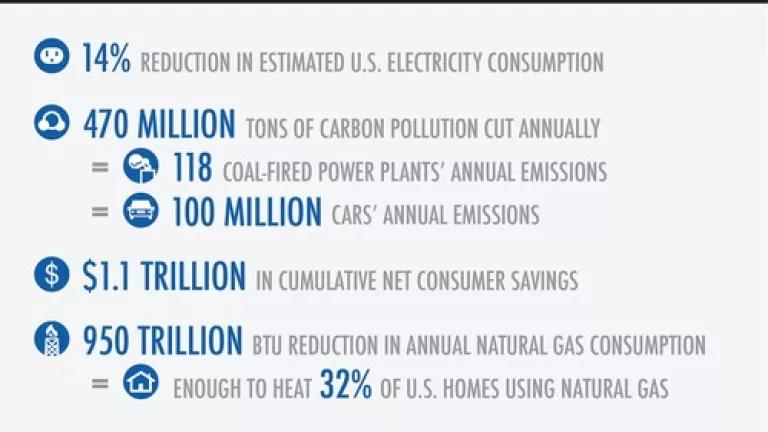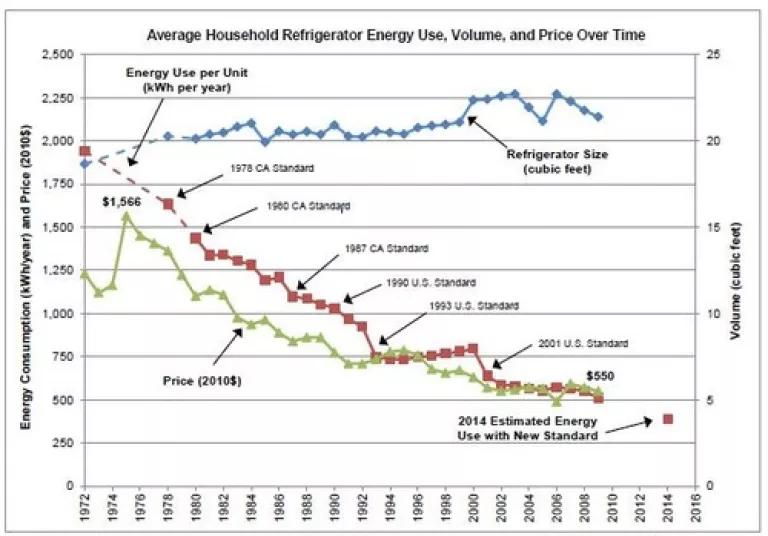
Another in NRDC's Year-End Series Reviewing 2014 Clean Energy Developments.
The Department of Energy (DOE) this year set final energy efficiency standards for seven products ranging from electric motors to commercial refrigeration equipment that will save consumers more than $54 billion net on their utility bills by 2030 and also proposed standards for five more—all in the interest of reducing consumer utility bills, cutting pollution, and lessening energy demand.
Meanwhile, standards to ensure that our refrigerators and room air conditioners waste less energy became effective, too. Increasing the efficiency of our appliances and equipment adds up to big savings on utility bills and avoids the need to generate as much electricity from dirty resources like coal that pollute our air and harm our health.
There’s no doubt that 2014 was a year of momentous progress when it comes to appliance and equipment efficiency standards—a significant policy tool that has been quietly chugging along for decades while reducing energy bills and cutting harmful power plant emissions. This chart shows just how significant they are—and the huge pollution and monetary savings we’re on track to enjoy between now and 2035 just from existing standards. Even greater savings from standards are yet to come in 2015 and beyond!
Source data: Appliance Standards Awareness Project
The rules set this year will cut cumulative electricity use by more than 527 billion kilowatt-hours—equivalent to the electricity used by 47 million U.S. homes each year—and also reduce cumulative carbon pollution emissions by 271 million metric tons, all by 2030! This is good progress toward President Obama’s Climate Action Plan goal of 3 billion metric tons of carbon pollution reductions from appliance, equipment, and federal building standards.
Rules set this year include:
- The first-ever efficiency standards for furnace fans—the little thought-about energy hog that circulates air from your furnace to the rest of the home and accounts for about 10 percent of household electricity use—will make them 40 percent more efficient and save consumers a net $15.8 billion on their energy bills!
- DOE set new standards for electric motors that greatly expand the scope of covered motors to achieve significant reductions in electricity: about 800 billion kilowatt-hours over 30 years of shipments or roughly enough to power 80 million U.S. homes for a year and cutting customer bills by a net $19.8 billion, making it one of the biggest energy-saving rules in DOE history! The standards are based on an agreement between the motor industry and efficiency advocates and bring previously unregulated motors—such as gear motors used in escalators and conveyance belts—up to the same levels of efficiency as other motors, achieving per unit savings of 3 to 8 percent.
- Commercial refrigeration equipment covers everything from the open air fridges used to store dairy and produce in grocery stores, to closed door fridges and freezers used to store meat, beer, and frozen foods, down to the ice-cream freezers typically found in convenience stores. The new standards will save consumers a net $9.7 billion on their energy bills. Savings from the updated standards vary by product: 12 percent for freezer cases, 28 percent for glass door supermarket refrigerators, and 40 percent for solid door “reach-in” fridges and freezers!
- Walk-in coolers and freezers are large insulated spaces that are typically big enough to walk into and used for bulk food storage in stores and restaurants. The new standards set requirements for walk-in components: the doors, panels and refrigeration equipment which are typically combined on-site to form the walk-in cooler or freezer. Under the new standards, refrigeration equipment will cost 10 to 38 percent less to operate, depending on the size of the system and cutting electricity bills by a net $6.2 billion.
- DOE set updated standards for the external power supplies, better known as power adaptors (those black boxes that connect many of our electronic and other household devices to wall outlets) that are pervasive in American homes. With more than 300 million new power adaptors shipped annually, making them 33 percent more efficient is a big deal and will save consumers a net $1.2 billion!
- DOE updated standards for metal halide lamp fixtures, the big bright dome-shaped lights found on football fields, warehouses, and big box stores. The new standards will cut energy bills by a net $1.3 billion.
- Just last week, DOE set updated standards for commercial clothes washers. These standards achieved modest energy savings and a net $300 million in utility bill savings for consumers, but left the deeper energy savings possible on the table.
All of these rules add to the significant energy and pollution savings put on the books since President Obama took office in 2009: in total, they will lead to over 2 billion metric tons of carbon pollution emission reductions by 2030.
That leaves close to 1 billion metric tons of carbon pollution reductions to be achieved from rules finalized over the next two years. Some of the rules to look for in 2015 include:
- Commercial air conditioners: DOE proposed a rule this fall that has the potential to achieve more savings than any other DOE energy efficiency standard to date.
- Residential furnaces: DOE will take up this long overdue rule in 2015.
- Commercial and industrial pumps: DOE is expected to propose a rule in 2015 based on a proposal negotiated by industry and advocates earlier this year through DOE’s formal negotiated rulemaking process.
- Other rules to look for include: Commercial and industrial fans, residential dishwashers, commercial boilers, battery charger systems, and more.
Also noteworthy in 2014: standards took effect for two major home appliances: room air conditioners and fridges, which means consumers today are experiencing savings from these standards. These standards were part of an agreement negotiated by industry and advocates back in 2010.

Source: Appliance Standards Awareness Project
Thanks to these standards, room air conditioners will use 10-15 percent less energy and most fridges will use 20-25 percent less. Since the first fridge standards in the 1970s, fridge energy use has decreased by over 75 percent (while prices have declined and fridges have gotten bigger and added features)—showing that efficiency is truly the low-hanging fruit that keeps growing back!
In addition to progress at the Federal level, California continued to work on new and updated standards for 15 product categories ranging from water faucets to the light bulbs that go into small recessed cans, and consumer electronics like computers, monitors, game consoles and modems and Wi-Fi routers. These standards have the potential to save Californians $2 billion annually in utility bills once in full effect. Many of these standards are likely to be finalized in 2015.
In all, 2014 was a great year for appliance and equipment standards, with even more energy savings to come in 2015!
